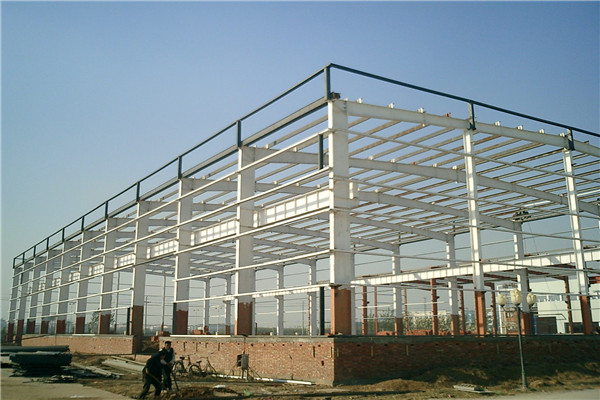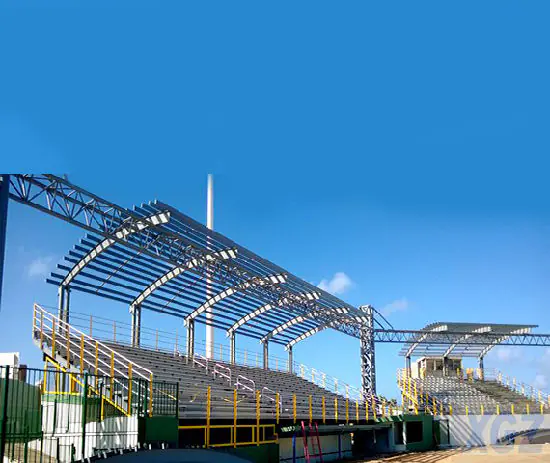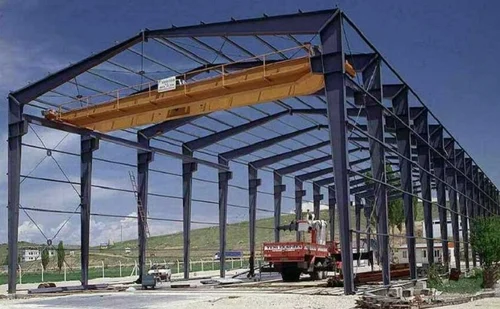Applications of Steel Warehouse Structures: A Modern Storage Solution
Explore the versatile, strong, and cost-effective applications of steel warehouse structures. A modern storage solution for your various industrial and business needs.
Steel warehouse structures have become an increasingly popular storage solution in various industries. With advantages such as versatility, strength, and cost efficiency, steel warehouse structure applications offer numerous benefits for businesses needing reliable and flexible storage spaces.
This article will delve into the applications of steel warehouse structures, their advantages, and essential design considerations. Whether you are an entrepreneur, logistics manager, or construction professional, this information will help you understand why steel warehouse structures are the top choice for modern storage needs.
From versatility and strength to cost-effectiveness and sustainability, we will explore the various aspects that make steel warehouse structures the ideal solution for a wide range of industrial applications. Additionally, we will discuss the complex yet essential design process to ensure that steel warehouse structures are optimized and tailored to the specific needs of each project.
1.Overview of Steel Warehouse Structures
Steel warehouse structures are buildings specifically designed using steel components as the primary construction elements. The application of steel warehouse structures has rapidly developed over the past few decades, becoming the preferred choice for various industries requiring efficient and reliable storage solutions.
Modern steel warehouses consist of various main components, including steel frames, roofs, walls, and foundation systems. The steel framework typically includes columns, beams, and trusses that provide strength and stability to the structure. Roofs and walls can be made from steel panels or other compatible materials, depending on the specific needs of the project.
Steel warehouse structure applications are diverse, covering various industrial sectors such as manufacturing, logistics, agriculture, retail, and even the public sector. Common usage examples include:
- Storage warehouses for finished goods and raw materials
- Distribution and logistics centers
- Manufacturing and assembly facilities
- Aircraft and ship hangars
- Agricultural and livestock warehouses
- Shopping centers and supermarkets
- Sports and recreational facilities
The main advantage of steel warehouse structures lies in their design flexibility. These buildings can be customized to various sizes, shapes, and configurations to meet specific user needs. Additionally, the ability to add features such as ventilation systems, natural lighting, and specialized equipment makes steel warehouses highly adaptive solutions.
With the advancement of technology and modern construction techniques, the application of steel warehouse structures continues to evolve. Innovations in design, materials, and assembly methods have enhanced the efficiency, reliability, and sustainability of these buildings, making them an increasingly attractive choice for various storage and industrial projects.
2.Advantages of Steel Warehouse Structures
Steel warehouse structures offer various advantages that make them the preferred choice for numerous storage and industrial applications. Here is a detailed explanation of these advantages:
2.1 Versatility
One of the primary advantages of steel warehouse structures is their exceptional versatility. Steel, as a construction material, allows for the design of buildings in various shapes, sizes, and configurations. This makes steel warehouse structures adaptable to a wide range of industrial needs and applications, from simple storage warehouses to complex manufacturing facilities.
This versatility is also evident in the ability to integrate various features and systems. For instance, steel warehouse structures can easily accommodate air conditioning, ventilation, natural lighting, and even specialized equipment such as cranes or conveyors. This flexibility enables users to optimize space and functionality according to their operational needs.
Additionally, steel warehouse structures can be designed to meet various aesthetic requirements. With diverse finishing options and architectural designs, steel warehouses can harmoniously integrate into various environments, from industrial zones to commercial areas.
2.2 Strength and Durability
Steel is known for being an incredibly strong and durable construction material. Steel warehouse structures have a high strength-to-weight ratio, allowing for the construction of large and tall structures without excessive internal support. This results in more spacious and flexible interior spaces.
Steel’s resistance to various environmental conditions is also a significant advantage. Steel warehouse structures can be designed to withstand wind loads, snow loads, and even earthquakes. With proper treatment and maintenance, steel is also resistant to corrosion, mold, and insect damage, which are common issues with wooden structures.
The durability of steel warehouse structures also means a longer lifespan. With appropriate maintenance, steel warehouses can last for decades, providing significant long-term investment value for their owners.
2.3 Cost-Effectiveness
Although the initial cost of steel warehouse structures may be higher compared to some alternatives, their long-term cost-effectiveness is highly appealing. Factors contributing to this cost-effectiveness include:
- Faster construction times, reducing labor costs and accelerating operational timelines.
- Lower maintenance costs due to the strength and durability of steel.
- Better energy efficiency, especially if designed with proper insulation systems.
- The ability to expand or modify with minimal costs.
- Higher resale value due to the durability and flexibility of the structure.
Additionally, the use of prefabricated components in the construction of steel warehouses can further reduce costs and construction time. These components are manufactured in factories under strict quality control, minimizing the likelihood of errors and waste at the construction site.
2.4 Expansion and Adaptability
A significant advantage of steel warehouse structures is their ability to adapt to changing business needs. Steel warehouses can be easily expanded or modified to accommodate growth or operational changes.
Expansion can be done horizontally by adding new bays or vertically by increasing the height of the structure. This process can often be completed without disrupting ongoing operations, providing valuable flexibility for growing businesses.
The adaptability of steel warehouse structures is also evident in the ease of changing interior layouts or adding new features. For example, adding mezzanines, changing storage systems, or integrating new technology can be done relatively easily in existing steel structures.
2.5 Sustainability
In an era where sustainability is a primary focus, steel warehouse structures offer several environmental advantages:
- Steel is a fully recyclable material. At the end of a building’s life, steel components can be recycled without losing quality.
- Steel warehouse construction generates less waste compared to traditional construction methods.
- Energy efficiency can be enhanced through proper design, such as the use of insulation panels and natural ventilation systems.
- Using lightweight steel reduces the load on foundations, decreasing the need for concrete and associated environmental impacts.
Additionally, the long lifespan of steel warehouse structures means more efficient use of resources in the long term, reducing the need for new construction and the disposal of old structures.
2.6 High Reliability
The reliability of steel warehouse structures is a key factor making them the preferred choice for various industrial applications. Several aspects contribute to this high reliability:
- Consistent quality: Steel components are manufactured to stringent standards, ensuring consistent quality throughout the structure.
- Predictable performance: Well-studied properties of steel allow for accurate calculations and performance predictions of the structure.
- Fire resistance: With proper treatment, steel structures can provide excellent fire resistance, enhancing building safety.
- Long-term stability: Steel has stable properties over time, with minimal changes in dimensions or strength due to environmental factors.
This reliability is crucial in industrial applications where safety, operational efficiency, and asset protection are top priorities.

3.Design of Steel Warehouse Structures
Designing steel warehouse structures is a complex process requiring consideration of various factors to ensure functional, safe, and efficient buildings. Here are some key aspects of designing steel warehouse structures:
- Needs Analysis: The first step in design is understanding the specific needs of the user. This includes considerations such as the type of goods to be stored, required storage volume, access and circulation needs, and special requirements like temperature or humidity control.
- Structural System Selection: Depending on size and requirements, designers can choose between rigid frame systems, portal systems, or arch structures. Each system has different advantages and applications.
- Load Calculations: Structural engineers must account for various loads, including dead loads (weight of the structure itself), live loads (stored goods and equipment), wind loads, snow loads (if relevant), and seismic loads.
- Structural Component Design: This includes designing columns, beams, trusses, and connections. Each component must be designed to withstand anticipated loads with adequate safety factors.
- Material Selection: Besides the primary structural steel, designers must choose materials for roofs, walls, and floors. Selection is influenced by factors such as thermal insulation, fire resistance, and aesthetic requirements.
- System Integration: The design must accommodate MEP systems (Mechanical, Electrical, and Plumbing), including ventilation, lighting, and fire safety systems.
- Environmental Considerations: Designers must consider factors such as building orientation, natural lighting, and energy efficiency to create sustainable structures.
- Regulatory Compliance: The design must meet all applicable building codes and regulations, including fire safety and accessibility requirements.
- Flexibility and Expansion: Good design will consider the potential for future expansion or modification, allowing adaptation to changing business needs.
- Cost Optimization: While safety and functionality are primary priorities, designers must also consider cost efficiency in material selection and construction methods.
The design process for steel warehouse structures usually involves collaboration between architects, structural engineers, and other specialists to ensure all building aspects are well-integrated. The use of modern design and analysis software allows for better design optimization, ensuring safe, efficient, and user-specific structures.

4.Conclusion
The application of steel warehouse structures has proven to be a highly effective and versatile solution for various modern storage and industrial needs. Advantages such as versatility, strength, durability, cost-effectiveness, expansion capability, sustainability, and high reliability make steel warehouse structures the top choice for many businesses and industries.
Careful design and thorough consideration of specific user needs allow for the creation of steel warehouse structures that not only meet functional requirements but also add value in terms of operational efficiency and long-term flexibility. With ongoing advancements in construction technology and materials, the application of steel warehouse structures is expected to continue evolving and adapting to the changing demands of the industry.
For decision-makers involved in construction projects or facility expansions, considering the application of steel warehouse structures can open up opportunities to create efficient, safe, and sustainable storage solutions. By understanding the advantages and design considerations outlined in this article, professionals can make more informed and strategic decisions. It is important to remember that while steel warehouse structures offer many benefits, each project is unique and requires careful analysis to ensure an optimal solution.
As technology and innovation in the construction industry progress, we can expect the application of steel warehouse structures to continue advancing. The integration of smart technology, the use of newer, lighter, and stronger materials, and an increasing focus on sustainable design are likely to shape the future of steel warehouse structures.
Ultimately, the successful implementation of steel warehouse structures depends not only on good design and construction but also on proper maintenance and management. With thorough planning, careful execution, and consistent maintenance, steel warehouse structures can become valuable and long-lasting assets for various types of businesses and industries.
By understanding and leveraging the advantages of applying steel warehouse structures, companies can enhance their operational efficiency, reduce long-term costs, and create a safer and more productive work environment. This is why steel warehouse structures continue to be the preferred choice for storage and industrial facility solutions in the modern era.



Post Comment